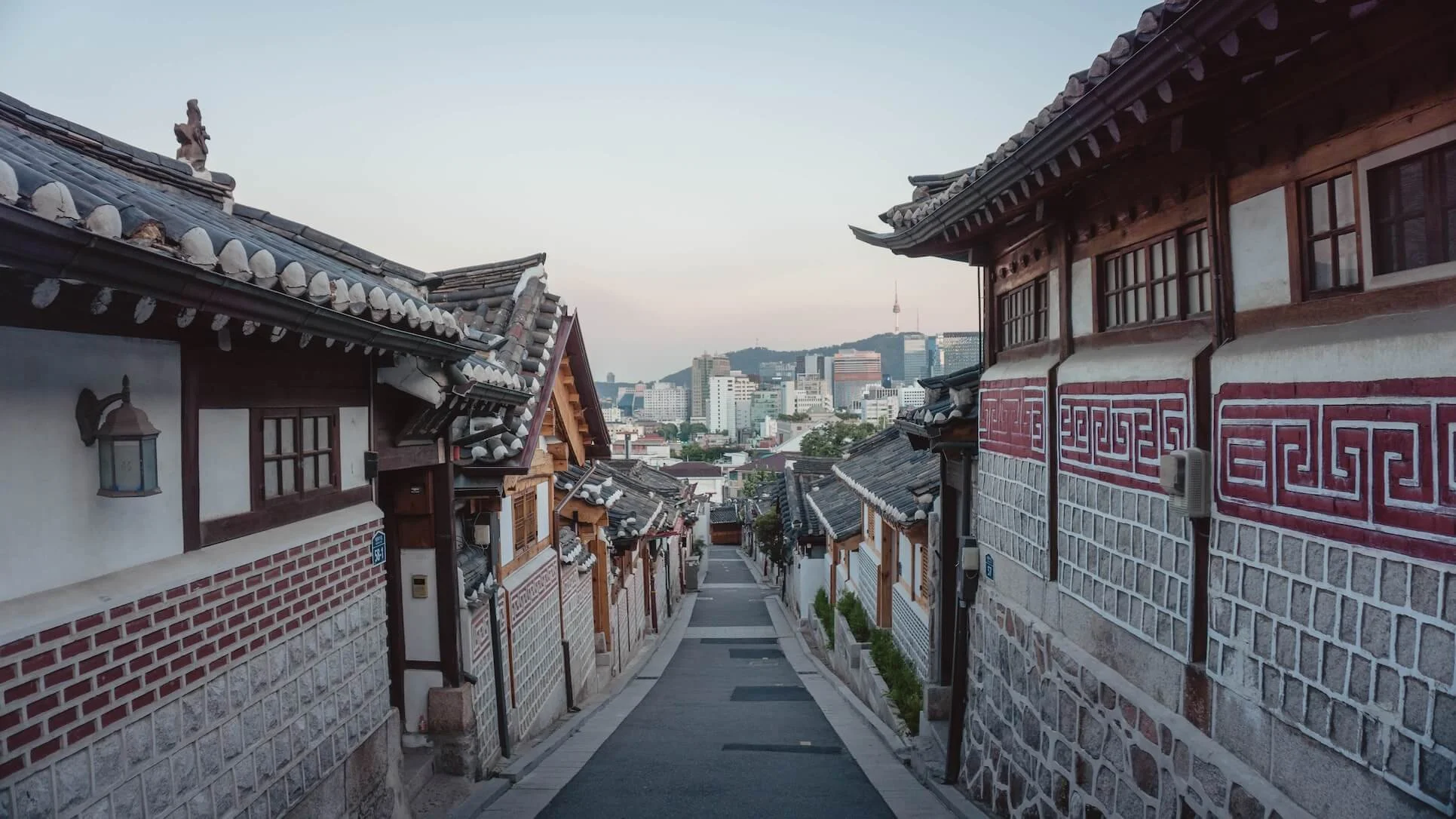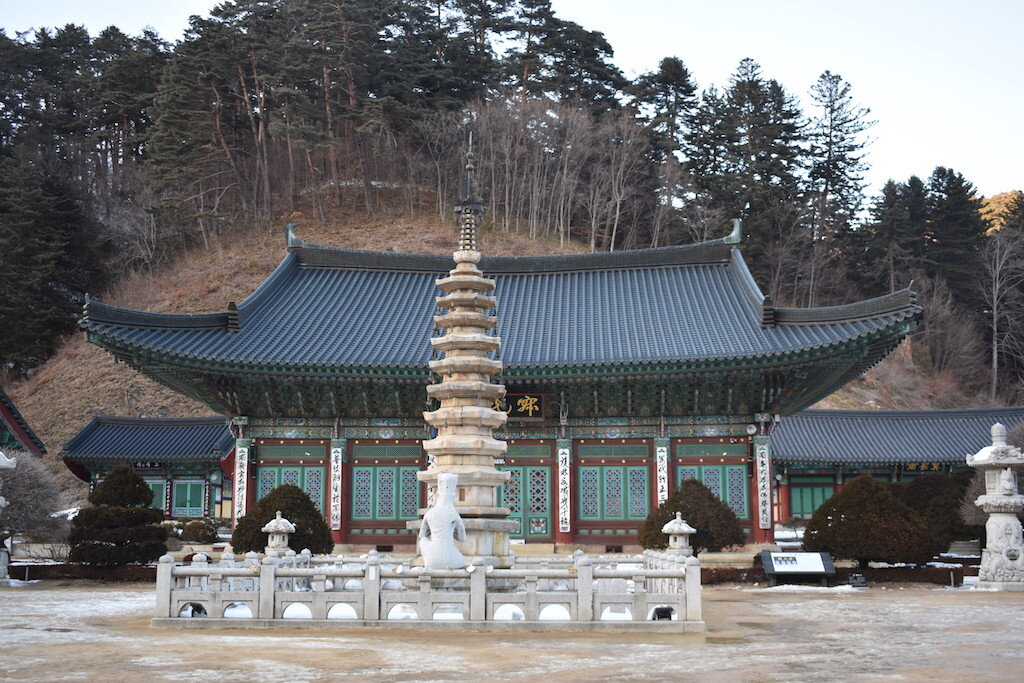Sangwonsa Temple Guide: Everything You Need to Know [2024]
/Tucked away in the mountains of Odaesan National Park, South Korea, Sangwonsa is a must-visit temple in Pyeongchang County. Read on to find out more about how to get to Sangwonsa Temple, and things to do there.
Beautiful mountain scenery surrounding Sangwonsa Temple in Odaesan National Park
History of Sangwonsa Temple
Tucked away in the mountains of Odaesan National Park near the popular Alpensia Resort and Yongpyong Resort, Sangwonsa is one of Pyeongchang County’s most beautiful sites.
Sangwonsa Temple is a beautiful temple built by Buddhist monk Ja Jang in the 12th year of Silla Queen Seondeok, and was rebuilt in the year 705. Tragically, the temple burnt down in 1946, but was restored again in 1947.
One of Sangwonsa’s beautiful buildings
There are many temples in Odaesan National Park, but this hidden gem is probably the most scenic as it is nestled amongst the hills and offers panoramic vistas of the many peaks of Pyeongchang.
Snowy Sangwonsa
We loved our visit to Sangwonsa, and would highly recommend checking out this peaceful spot if you’re headed to Odaesan.
What’s there to see at Sangwonsa Temple?
Famous Bronze Bell of Sangwonsa pictured on the right
Sangwonsa Temple is made up of a collection of ancient buildings and ornaments. One of the most significant is the Bronze Bell of Sangwonsa, which is actually considered South Korea’s 36th National Treasure because it is the nation’s oldest bronze bell – pretty neat, huh?
Aerial view of Sangwonsa Temple’s many buildings
Other interesting features of the temple include the Statue of Child Manjusri, and the Gwangdaegeori building at the entrance of the temple.
Sangwonsa is a unique temple as it sits on top of a hill
Walking around the grounds is the best way to get acquainted with all that Sangwonsa has to offer.
How to get to Sangwonsa Temple?
Public Transport
If you’re taking public transport, get to Jinbu Station by KTX. The station is also sometimes referred to as Odaesan Station. From Seoul, there are about 10 trains running a day, and it takes about 1.5 hours to reach Jinbu.
Balcony at Sangwonsa Temple
Sangwonsa Temple in winter
Sangwonsa Temple was magical in winter weather
The train fare varies depending on which class ticket you buy, but the cheapest non-reserved seat costs 18,700 KRW for adults and 9,300 KRW for children.
From Jinbu Station, take Bus No. 55 and get off at Sang-Wonsa stop. If you’re unsure, just mention to the bus driver that you’re headed towards Sangwonsa Temple and double check that the bus is headed there too. There are 12 buses a day, with a bus coming once ever 1-2 hours or so. The journey will take about 40 minutes and cost 3000 KRW one way.
To return, just walk back to the bus stop and take the bus stop going back to Jinbu.
Taxi
By far the most convenient option would be to take a taxi to Sangwonsa temple. Prices vary depending on where you’re coming from.
As a point of reference, it cost us 40,000 KRW one-way to reach Sangwonsa from Alpensia Ski Resort. The ride took about 30 minutes.
Tour
If you plan to visit both Woljeongsa and Sangwonsa Temple, then this autumn tour lets you see both in one day.
Walk
If you’re already in Odaesan National Park, it’s possible to walk to Sangwonsa. For example, reaching Sangwonsa from the Woljeongsa Temple will take about 2.5 hours.
Sangwonsa Temple
Opening Hours and Fees
Unique ornaments of Sangwonsa
To enter Odaesan National Park, you’ll have to pay an entrance fee.
Entrance Fees
Adults 3,000 won / Groups 2,500 won
Teenagers 1,500 won / Groups 1,000 won
Children 500 won / Groups 400 won
* Adults (ages 19-64) / Teenagers (ages 13-18) / Children (ages 7-12)
* Groups: 30 people and more
* Preschoolers (ages 6 & under) may enter for free
Parking Fees
If you’re coming by car, you’ll also have to pay a parking fee that varies depending on what type of vehicle you’re driving.
Compact vehicles 2,000 won
Mid-sized vehicles 4,000 won / 5,000 won (Peak season)
Large vehicles (bus) 6,000 won / 7,500 won (Peak season)
* Peak season: April, May, July, August, October, November
Opening Hours
There doesn’t appear to be a set closing time for Sangwonsa Temple but we recommend visiting safely between 8:30am – 5:30pm during daylight hours.
Is Sangwonsa Temple worth visiting?
Ralph at Sangwonsa Temple
Absolutely. Even though the temple is a little isolated from everything else and quite difficult to get to, it was worth the money and effort visiting. Sangwonsa Temple ended up being one of the most uniquely picturesque stops on our South Korean adventure.
What else can I do in Odaesan National Park?
Fred at Sangwonsa Temple
There are a bunch of trails you can embark on if you’re in the mood for a hike.
The Birobong Peak Course takes you from Sangwonsa to the highest peak in Odaesan National Park, standing at 1,563m above ground. The trail is considered quite easy and will take around 3-5 hours for a round trip.
Other courses in the National Park include the Durobong, Dongdaesan and Sogeumgang Course.
Read more about courses on offer here.
You can also easily visit nearby Woljeongsa Temple, which is about a 20-minute car ride from Sangwonsa. If you’re taking a taxi, it’ll cost about 15,000KRW.
Nearby Woljeongsa Temple is also worth a visit
You can also catch Bus No. 55 again, stopping at Woljeongsa Temple stop.
Woljeongsa fir forest trails
Near Woljeongsa, you can also wander around the Woljeongsa fir forest trails.
To read more about Woljeongsa Temple, check out our post on it here.
















